|
|
Circulatory System
- Functions (circulation of oxygen, nutrients, hormones, ions, and fluids; removal of metabolic waste)
- Oxygen delivery to tissues
- diffuses into the blood in alveolar (lung) capillaries
- binds to hemoglobin in red blood cells
- gets transported to tissues
- used in cellular respiration
- Carbon dioxide delivered out
- cellular respiration makes CO2: carbonic anhydrase converts it to bicarbonate.
- CO2 gets transported by blood: dissolved CO2, dissolved bicarbonate ion (major), bound to hemoglobin and plasma proteins
- diffuses out of the alveolar capillaries
- exhaled out
- Nutrients
- nutrients absorbed (either by diffusion or active transport) into blood stream in the small intestines.
- nutrients can also be released into the blood stream by cells. For example, glucagon causes glucose to be released into the blood stream.
- nutrients can be taken up by cells. For example, insulin causes cells to take in glucose from blood.
- Hormones released by endocrine glands, circulate the blood in order to reach their target cells.
- Fluids and ions circulate the blood and are regulated by how much reabsorption of water and salt occurs in the kidney.
- Urea = metabolic waste, travels in the blood to the kidneys, where it is filtered out and passed in urine.
- Role in thermoregulation
- Vasoconstriction conserves heat. When it's cold, vasoconstriction occurs in the arterioles that feed the skin. Less blood flows near the surface of the skin, less heat lost.
- Vasodilation cools you down. When it's hot, vasodilation occurs in the arterioles that feed the skin. More skin blood flow, more heat lost to the surroundings.
- Four-chambered heart (structure, function)

- Deoxygenated blood returns to the heart: superior/inferior vena cava → right atrium
- Deoxygenated blood gets pumped to the lungs: right atrium → right ventricle → pulmonary artery → lungs
- Blood arrives at the lungs and gets oxygenated.
- Oxygenated blood returns to the heart: lungs → pulmonary vein → left atrium
- Oxygenated blood gets pumped to the body: left atrium → left ventricle → aorta
- Blood going through the heart including the valves
- Vena cava
- Right atrium
- Tricuspid valve
- Right ventricle
- Pulmonary valve
- Pulmonary artery
- Lung
- Pulmonary vein
- Left atrium
- Bicuspid (Mitral) valve
- Left ventricle
- Aortic valve
- Aorta
- Systolic and diastolic pressure
- blood pressure = pressure blood exert on the walls of the blood vessel.
- systolic pressure = blood pressure when blood is being pumped (the ventricles are contracting).
- diastolic pressure = blood pressure when blood is not being pumped (the ventricles are relaxing).
- Pulmonary and systemic circulation
- Pulmonary circulation = heart → lungs → back to heart = oxygenates blood
- Systemic circulation = heart → body → back to heart = delivers oxygenated blood to body
- Pulmonary circulation = shorter than systemic circulation = less resistance = less blood pressure.
- Systemic circulation: vasodilation when oxygen levels are low → more blood flow to oxygen-starved tissue.
- Pulmonary circulation: vasoconstriction when oxygen levels are low → less blood flow to low oxygen/blocked alveoli → more blood flow to good alveoli where gas exchange can occur.
- Arterial and venous systems (arteries, arterioles, venules, veins)
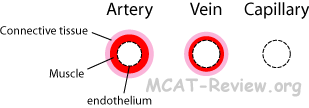
- structural and functional differences
- Blood flows from artery → arteriole → capillary → venule → vein.
- Artery
- Elastic artery
- Aorta and its major branches.
- Major function = provide elastic pipe for blood straight out of the heart.
- Lots of elastic tissue.
- Layers: endothelium, smooth muscle, connective tissue.
- Not active in vasoconstriction.
- Muscular (distributing) arteries
- Major function = distribute blood to specific organs.
- Lots of muscle.
- Layers: endothelium, lots of smooth muscle, connective tissue.
- Some activity in vasoconstriction.
- Arteriole
- Ranges from being like a smaller version of the artery, to being a larger version of the capillary with smooth muscles spiralling around it.
- Major function = controls blood flow to the capillaries.
- Active in vasoconstriction. The arterioles allow the body to control which tissues gets more blood.
- The arteriole is the most important site for vasoconstriction. Although other vessels are capable of vasoconstriction, you should always think of the arteriole when you see vasoconstriction.
- Capillary
- Layer: single cell thick endothelium.
- Major function: blood-tissue solute exchange.
- Not active in vasoconstriction.
- Venule
- Ranges from being like a large capillary to being like a small vein.
- Major function: merge of capillaries to be conducted to veins.
- No vasoconstriction.
- Vein
- Layers: endothelium, smooth muscle, connective tissue.
- Major function: returns blood back to the heart.
- Has valves to prevent the back flow of blood.
- Breathing, skeletal muscles, and smooth muscle adaptations help blood flow through the vein at low pressure.
- Vasoconstriction can occur in the vein.
- You can argue that the aorta has a single aortic valve right where it connects to the heart. But for the purposes of the MCAT, arteries don't have valves, veins do.
- Thickness: artery > vein > arteriole > venule > capillary
- Differences between arteries and veins
- arteries are thicker, more muscular than veins.
- veins have valves, arteries don't.
- arteries carry blood away from the heart (oxygenated except for pulmonary artery). Veins carry blood back into the heart (deoxygenated except for pulmonary vein).
- Differences between artery and arteriole
- arterioles are smaller.
- vasoconstriction occurs predominantly at the arterioles.
- pressure and flow characteristics
- Blood pressure of arteries > arterioles > capillaries > venules > veins
- Blood pressure is highest in the arteries (specifically the aorta) because the heart pumps directly into the aorta.
- Blood pressure is lowest in the veins (specifically the vena cava) because flow resistance brings the pressure down.
- Blood pressure is also lower when you elevate a blood vessel (think physics, P = ρgh, where h is the depth - raising your arm like taking it to shallower water)
- Blood pressure can be regulated by vasoconstriction (increase bp), vasodilation (decrease bp), and hormones (ADH, aldosterone, renin, adrenaline all increases bp).
- Blood flows from artery → arteriole → capillary → venule → vein.
- Blood squirts from arteries, flows from veins, and oozes from capillaries.
- The elasticity of arteries causes blood to flow even when the heart is resting between pumps (this is why your diastolic blood pressure is not zero)
- Adaptations that help blood flow through the vein at low pressure:
- Respiratory pump: when you inhale, your stomach squeezes on the veins, and your chest sucks on it.
- Muscular pump: skeletal muscle squeezes on the veins when you exercise.
- When you're scared, smooth muscles around veins constrict and squeezes blood.
- Capillary beds
- mechanisms of gas and solute exchange
- Diffusion is the major mechanism of gas and solute exchange, whether it is diffusion as a free molecule, or bound to carrier proteins.
- Continuous capillary
- No pores on endothelial cells. May have clefts at cell boundaries.
- Exchange may occur through the clefts, or by vesicle trafficking through endothelial cells.
- Found in skin and muscles.
- Blood-brain barrier = sealing of clefts by tight junctions.
- Fenestrated capillary
- Small pores, large enough for molecules, but not blood cells to leak through.
- Found in small intestines to facilitate nutrient absorption.
- Found in endocrine organs to allow passage of hormones.
- Found in kidneys to allow blood filtration.
- Sinusoidal capillary
- Large pores, large enough for blood cells to leak through.
- Found in lymphoid tissues, liver, spleen, bone marrow.
- Large pores facilitate lymphocyte travel to tissues.
- Large pores also facilitate blood cell modifications.
- mechanism of heat exchange
- radiation - your body gives off IR signal.
- conduction - you touch something cold, or take a hot bath.
- evaporative cooling - you sweat, and it cools you as it evaporates.
- source of peripheral resistance (no longer tested)
- Blood viscosity: blood cells and plasma proteins give blood a higher resistance to flow compared to water. Diseases that increase the amount of blood cells increase resistance.
- Total blood vessel length: more blood vessels you have, the more resistance to flow. Overweight = more blood vessels to service the fat cells = more resistance.
- Blood vessel diameter: vasoconstriction increases resistance, vasodilation decreases it. Obstruction from plaques inside blood vessels also increases resistance.
- Composition of blood
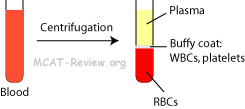
- plasma, chemicals, blood cells
- plasma = water and chemicals = mostly water, plasma proteins, electrolytes, gases, nutrients, wastes, hormones.
- blood cells
- red blood cells (RBCs or erythrocytes)
- contain hemoglobin, transports O2 and CO2
- no nucleus, which gives it a biconcave disk shape
- most abundant cell in blood.
- white blood cells (WBCs or leukocytes)
- larger than RBCs
- lobed or irregular shaped nuclei
- fights off pathogens
- platelets
- technically not cells, but cell fragments
- responsible for clotting blood
- erythrocyte production and destruction (spleen, bone marrow)
- Bone marrow = makes RBCs from stem cells.
- Spleen = destroys aged and damaged RBCs.
- Other sites for RBC destruction include the liver and bone marrow.
- Components of hemoglobin from destroyed RBC gets recycled
- iron = recycled
- heme → bilirubin → bile → excreted in feces
- protein (globin) = broken down to amino acids
- regulation of plasma volume
- Blood osmolarity
- Higher blood osmolarity → water goes into blood → higher blood volume
- Lower blood osmolarity → water goes into tissues → lower blood volume
- ADH (vasopressin): ↑ water reabsorption in kidney.
- Aldosterone: ↑ salt reabsorption, leads to ↑ water reabsorption in kidney.
- coagulation, clotting mechanisms, role of liver in production of clotting factors
- Platelets contain enzymes and chemicals needed involved in the clotting process.
- Liver produces clotting factors (eg. fibrinogen), which circulates in blood plasma.
- Coagulation = liquid blood → gel
- Clotting mechanism:
- Platelet plug formation: wound + platelets → platelets clump at wound, release chemicals, activates clotting factors.
- Coagulation: series of clotting factor/enzyme activation that ends in fibrinogen → fibrin. Fibrin being the fiber mesh that seals the clot.
- Retraction and repair: clot contracts, gets compact, but after the wounded blood vessel repairs itself, the clot dissolves.
- Oxygen and carbon dioxide transport by blood
- hemoglobin, hematocrit
- hemoglobin = (heme + globin) x 4
- heme = chemical ligand binding iron
- globin = protein that surrounds heme
- 4 subunits of the heme-globin complex form a tetramer called hemoglobin.
- hemoglobin can bind oxygen and carbon dioxide
- hematocrit = % volume of blood that is red blood cells, usually ~ 45%
- oxygen content
- each iron atom in hemoglobin can bind one oxygen.
- hemoglobin has 4 subunits containing 4 iron atoms.
- each RBC has hundreds of millions of hemoglobin molecules.
- oxygen affinity
- hemoglobin has a sigmoidal oxygen binding curve. This is because oxygen binding to one subunit "relaxes" the conformation of the other subunits, and makes it easier for additional oxygen to bind.
- carbon monoxide binds hemoglobin tighter than oxygen.
- fetal hemoglobin binds oxygen tighter than adult hemoglobin.
- myoglobin binds oxygen tighter than hemoglobin.
- Details of oxygen transport: biochemical characteristics of hemoglobin
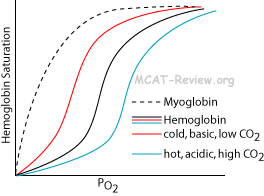
- modification of oxygen affinity
- Higher levels of carbon dioxide → lower oxygen affinity of hemoglobin.
- Lower pH → lower oxygen affinity.
- Higher temperature → lower oxygen affinity.
- Working muscle = hot, acidic, high CO2, needs oxygen. So, hemoglobin must unload its oxygen, and it does this by lowering its oxygen affinity.
Lymphatic System
- Major functions
- equalization of fluid distribution
- Interstitial fluid pressure > lymphatic pressure → lymph vessel flaps open → interstitial fluid enters lymphatic capillaries → lymphatic circulation merges with veins → returns the fluid to blood
- Interstitial fluid pressure < lymphatic pressure → lymph vessel flaps close → prevents lymph from leaking back out.
- transport of proteins and large glycerides
- fats get absorbed into the lacteals in the small intestine.
- lacteal = lymphatic capillary in the small intestine.
- plasma protein that leaked into interstitial fluids get returned to the blood via the lymphatic system.
- production of lymphocytes involved in immune reactions
- technically, lymphocytes are produced in the bone marrow from blood stem cells.
- however, lymphoid tissues provide a place where lymphocytes can reside, proliferate, and differentiate.
- lymphoid tissue is found in lymph nodes, thymus, and scattered throughout various organs.
- lymph tissue contains many lymphocytes that cleans/filters lymph.
- thymus is the place where T cells mature.
- return of materials to the blood
- cells and plasma proteins that leak out of the blood capillaries gets collected by the lymphatic capillaries and returned to the vein.
- Composition of lymph (similarity to blood plasma; substances transported)
- Lymph = stuff that leaks out of the capillaries = mostly water, plasma protein, chemicals, and white blood cells.
- Source of lymph (diffusion from capillaries by differential pressure)
- blood plasma from capillaries → interstitial fluid → lymph → returned to blood
- Lymph nodes (activation of lymphocytes)
- Lymph nodes are concentrated with white blood cells.
- When pathogens or foreign antigens get inside a lymph node, lymphocytes that reside there get activated.
- Activation = lymphocytes start releasing chemicals that stimulate an immune response = proliferation, antibody production, release of cytokines.
Immune system: Innate and Adaptive Systems
- Cells and their basic functions
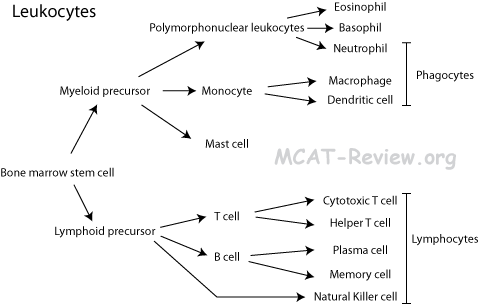
- macrophages, neutrophils, mast cells, natural killer cells, dendritic cells
- macrophages = phagocytose pathogen and then act as antigen presenting cell.
- neutrophils = Polymorphonuclear leukocytes = PMNs = phagocytose pathogen and destroys it.
- mast cells: release histamine during an allergic response, bring about inflammation.
- natural killer cells: kills infected/abnormal cells.
- dendritic cells: the best antigen presenting cells.
- T-lymphocytes
- Matures in the Thymus.
- cytotoxic T cells recognize antigen on infected cells, and signal for apoptosis.
- helper T cells recognize antigen on antigen-presenting cells, and signal for activation of B cells, T cells, and macrophages.
- B-lymphocytes, plasma cells
- Matures in Bone marrow.
- B cells form plasma cells and memory cells when exposed to antigen.
- plasma cells = secrete antibody.
- memory cells = stick around in case the same antigen attacks in the future.
- Tissues
- bone marrow
- all blood cells arise from stem cells in the bone marrow.
- B lymphocytes differentiate in the bone marrow.
- spleen
- Provides a site for WBCs to reside and proliferate.
- Removes pathogens from blood.
- Removes old RBCs and platelets.
- thymus: T lymphocytes differentiate in the thymus.
- lymph nodes
- Provide a site for WBCs to reside and proliferate.
- Removes pathogens from lymph.
- Residing lymphocytes monitor lymph for foreign antigens, and initiate an immune response when exposed to foreign antigens.
- Basic aspects of innate immunity and inflammatory response: Innate = first line of defense = kills anything that doesn't look right = not specific to a particular pathogen / antigen
- Skin: natural flora, layer of keratin.
- Mucus membranes: traps pathogen in mucus, and cilia moves it out.
- Phagocytes: engulf pathogen.
- Natural killer cells: destroy infected cells.
- Antimicrobial proteins: tears (lyse bacteria), interferons (interfere with virus replication), complement (punches holes in cell/pathogen membrane).
- Fever/inflammation: WBCs are more active at higher temperature, and inflammation recruits WBCs to site of infection by sending out chemical signals and making capillaries more permeable.
- Adaptive immunity = highly specific for a particular pathogen / antigen.
- antigen presenting cells present foreign antigen on their surface.
- antigen is recognized by T and B cells.
- cytotoxic T cells kill infected cells.
- helper T cells activate macrophages, T and B cells.
- B cells produce antibodies.
- antibodies bind to antigens and bring about
- neutralization: pathogen can't adhere to host cell
- opsonization: makes it easier for phagocytosis
- complement activation: kills infected cell by punching holes in cell membrane.
- memory cells are made that are much more efficient (does not need T cell activation) in proliferating and making antibodies in case the same infection strikes in the future.
- memory cells allow the body to mount a greater, and more sustained response against the same pathogen during secondary response.
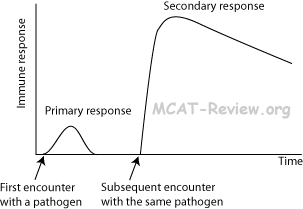
- Concept of antigen and antibody
- Antibody = lock, Antigen = key. Each antibody is specific to the binding of an antigen.
- Antibody is like a Y, the tips of the fork bind antigen.
- The tips of the fork are called hypervariable regions because they are unique to each antigen-specific antibody.
- The antibody consists of 2 light chains and 2 heavy chains linked together by disulfide bonds.
- Structure of antibody molecule
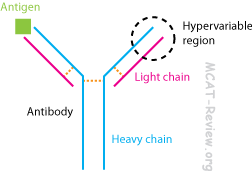
- Mechanism of stimulation by antigen; antigen presentation
- pathogen enters antigen-presenting-cell (APC)
- pieces of the pathogen gets displayed at the surface of APCs.
- T cell receptors recognize the presented antigen, and activates various immune responses.
- scenario 1: extracellular pathogen
- macrophage engulfs pathogen.
- pieces of the pathogen becomes the antigen and gets presented at the macrophage's cell surface.
- helper T cells recognize the presented antigen, and activates macrophages to destroy pathogen. Helper T cells also activate B cells to produce antibodies against the pathogen.
- scenario 2: intracellular pathogen
- pathogen invades host cell.
- pieces of the pathogen gets presented on the host cell surface.
- cytotoxic T cells recognize the presented antigen, and signals the infected cell to self-destruct.
|
|
